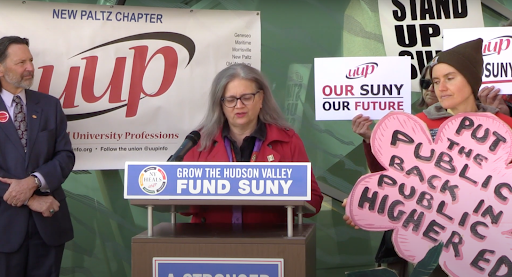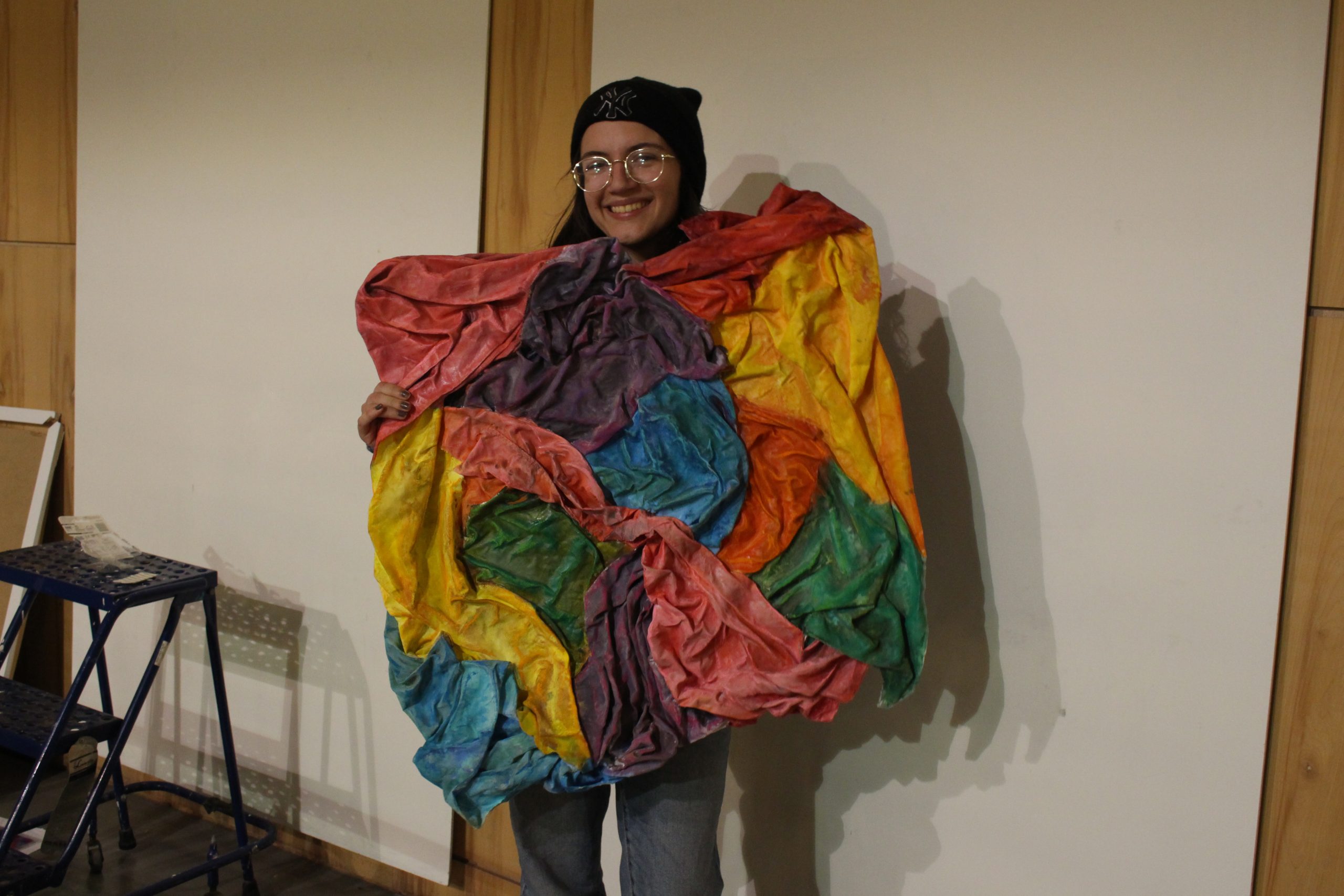Precarious payouts and uncertain futures, available at your local SUNY

Photo courtesy of UUP
Back in 2011, Peter Brown, then the head of the union that represents faculty at SUNY New Paltz, the United University Professionals (UUP), likened part of the workforce he represented to “domestic servants.” Brown gathered 2,000 signatures for a petition demanding better pay for adjunct professors and lecturers; these are part-time educators who typically are “appointed to teach one or two courses per semester,” according to the SUNY website. SUNY schools require a minimum of a master’s degree, with a Ph.D. preferred for the adjunct position.
Today, over ten years after Brown’s statement, not much has changed. UUP is still the country’s “largest higher education union,” and it represents all schools within the SUNY system. However, adjuncts are still taken for granted by SUNY.
SUNY New Paltz’s Uber Educators
The current UUP New Paltz Chapter Vice President for Contingents, Leigh Dodson, calls adjuncts “‘Uber’ educators,” meaning adjuncts are like Uber’s low-wage, self-contracting taxi drivers.
According to Dodson, contingent faculty, or part-time educators, “are the folks with the least job security [and] the least protections.”
“We’re Uber educators. You have to rate me five stars on Yelp or I won’t get my job back,” says Dodson.
Dodson serves as a representative for all non-tenured faculty in their role as vice-president for contingents, and they’re a proxy voice for adjunct concerns at union meetings. Dodson is also a lecturer in the Women’s, Gender and Sexuality Studies Department.
At SUNY New Paltz, there are currently around 350 adjuncts, making them around 50% of the school’s total faculty, according to Dodson.
“There’s a lot more adjuncts now than there used to be,” Dodson explains. “Since the pandemic, because of all the cuts, they can’t fill new lines and hire new full-time tenure track faculty. So they have to plug the holes with adjuncts.”
Lines are allocated funds budgeted specifically for full-time faculty and staff within an academic department or program. When school administrations don’t add new lines, adjuncts fill these gaps. It’s often much cheaper and less of a commitment to hire adjuncts than it is to hire full-time faculty, according to Dodson.
Struggling To Get By
Despite comprising roughly half of the school’s faculty, a major concern for adjuncts is how little they’re paid. Through their renewed contract for 2023-2024, adjuncts get paid a minimum of $3,500 for a three-credit course. For many adjuncts, teaching one or two courses isn’t enough income, so adjuncts across SUNY New Paltz seek to teach at other college campuses. Others rely on side jobs and gigs to get by.
“Let’s say you’re teaching two classes a semester, with the best rates, that’s $14,000* a year. That puts you way below the poverty line,” says César Barros, the UUP New Paltz chapter vice president for academics. “That’s not enough, so if you’re teaching at New Paltz, you’re going to look into other colleges. You’re going to look at Marist, at Vassar, at the community colleges.”
In Ulster County, as depicted by the graph below, the fair market rent (FMR) for a two-bedroom apartment has increased over time, more notably after 2020. Adjunct monthly earnings for two courses, however, have remained constant until 2023.
Adjuncts could earn more if they were retained for consecutive semesters, with an opportunity to get a 2% raise for each year they stay on. These raises, however, are not default.
This year, the FMR is only slightly below adjuncts’ total earnings in a month.
Comparably, adjunct earnings in a week for two courses have become more and more similar to Ulster County’s minimum wage. Through 2023, adjunct earnings have remained constant, whereas the minimum wage has seen increases every year since 2015.
Want A Raise? Think Again
The last UUP contract expired in July 2022. For the first time ever, UUP’s new contract established a state-wide minimum base salary for adjuncts. This was a big victory for contingent faculty and for the UUP as a whole. However, adjuncts seeking raises beyond this base pay must go through a process known as a Discretionary Salary Increase (DSI). If granted, the raises are typically not much.
“It’s laughable,” Dodson says. “You have to put together a packet of all teaching materials. Mine are between 60 to 90 pages of syllabi and evaluations, all of this stuff every year, just to get $100 or $200 added on to your base.”
For many adjunct faculty, the DSI process isn’t even worth it. “Out of 250 or 300 adjunct faculty, maybe only 20 will apply,” says Dodson. And while only a few adjuncts get these raises, contingent faculty originally didn’t even qualify for them.
“Management loves DSI because it has that discretionary piece,” says Elizabeth Wilson, the UUP New Paltz chapter president. “SUNY administrators love to have DSI because that’s their carrot that they can dangle to get people to play nice with them. It’s perceived as a management tool.”
Another major concern for adjunct faculty is the uncertainty of being hired again. Since they’re hired per semester, they may not know if they’re set to work until even a week before the semester starts, according to Barros. This causes delays in payroll, with adjuncts waiting up to halfway through the semester until they receive their paychecks.
Recent Contract Wins, With A Catch
Sometimes, classes taught by adjuncts won’t reach the minimum number of students for enrollment. When this happens, the school will cancel the class, leaving them without a course to teach. Another situation, known as “bumping,” is when a full-time faculty member has a course that doesn’t fill. To solve this, the administration will take a fully-enrolled course away from one of the adjuncts within the department or program, and they’ll give it to the full-time faculty.
“It used to be they weren’t allowed to do that,” says Wilson. “But, in the new contract, language that prevented “bumping” was removed.”
Establishing adjunct pay raises and minimums was a major win for UUP. However, there have been “trade-offs,” says Wilson.
The previous contract, which expired last summer, stated adjunct faculty needed to teach two classes minimum to access healthcare benefits. With the new contract, the language changed to six credits. If adjunct faculty can’t teach six or more credits a semester, they can’t have benefits.
This leaves faculty who teach two or three single-credit courses without benefits, even if their workloads match those teaching two to three-credit courses.
“We wound up getting the salary minimum partly in a horse trade,” says Wilson. “With negotiations, you’ve got to do trade-offs from time to time, and that was one of them.” “We’re still figuring out how exactly that’s going to play out.”
It Doesn’t Stop Here
In the meantime, Dodson isn’t taking the recent contract win as the end. Their goal is to continue advocating for adjuncts, and soon, establish a contingents’ concerns committee. Dodson says this committee “would advocate for increasing job security for all contingents and course minimums for adjuncts.”
“Our working conditions are students’ learning conditions,” Dodson stresses. “That’s the most important point.”
*This story has been updated. After consulting with César Barros we realized we’d miscalculated the figure.
